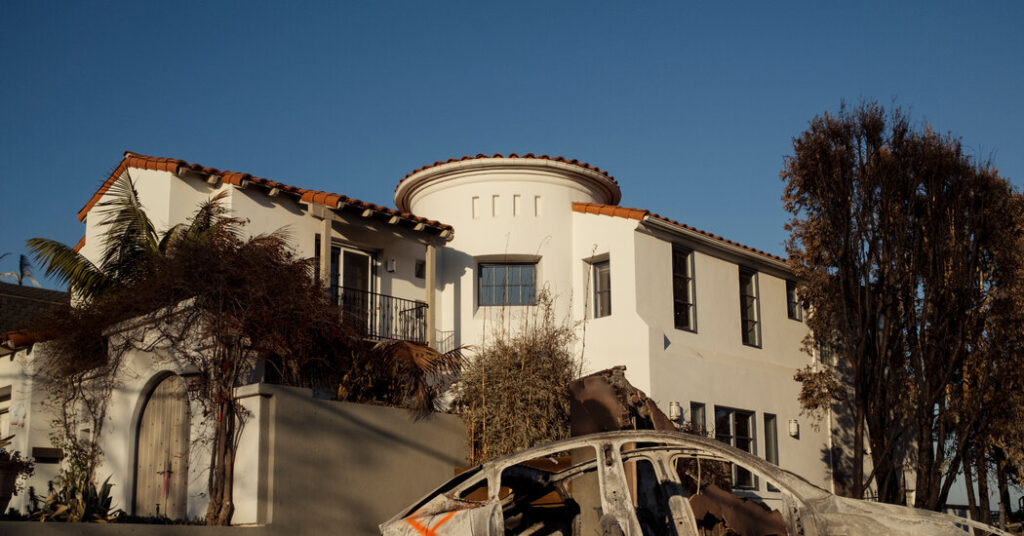
State Farm will be allowed to temporarily charge an extra 17 percent for homeowners’ insurance policies in California, after the state gave the company permission, in the wake of the catastrophic fires. The insurer will be allowed to charge the higher rate at least until a hearing later this year, the state announced on Tuesday.
The insurance giant already received a 20 percent rate increase last year, a move that a consumer watchdog group, as well as homeowners struggling to be paid after their homes were destroyed in January in the Los Angeles fires, criticized as unfair and unfounded.
State Farm requested the emergency rate increase in February, the month after fires ripped through the Pacific Palisades and Altadena neighborhoods of Los Angeles, razing over 16,000 homes and structures. The company — which insures one out of every five homes in California or roughly 1 million homeowner customers — had requested even more: a nearly 22 percent rate increase on homeowners’ policies, citing a “dire situation.”
California, like other states hit by natural disasters, has faced threats from major insurers: Raise rates, or we leave the state, said Carmen Balber, the executive director of Consumer Watchdog, which led the effort to oppose the rate increase in hearings this spring.
“The commissioner has shown a tendency to roll over in the face of insurer threats to leave,” Ms. Balber said. The increase “adds insult to injury” at a time when many homeowners insured by State Farm have reported delays or attempts by State Farm to lowball claims following the fires earlier this year, she added.
In a statement, Ricardo Lara, the state’s insurance commissioner, presented the rate increase as a difficult compromise for consumers. “Let me be clear: We are in a statewide insurance crisis affecting millions of Californians,” he said. “Taking this on requires tough decisions.”
An administrative judge inside the California Department of Insurance approved the interim rate increase, following a hearing in April in which lawyers for Consumer Watchdog repeatedly asked State Farm to open its books and show why it needed such a large infusion of cash. According to Ms. Balber, the insurer refused to provide paperwork corroborating the insurer’s dire financial straits.
Meanwhile, the consumer group’s own actuaries prepared a simulation of the State Farm General Insurance Company’s earnings from premiums and projected losses from recent wildfires. The actuaries concluded both that State Farm had exaggerated the financial strain and that the rate increase was not justified, Ms. Balber said.
The interim rates go into effect on June 1. There is a chance that the rates can be challenged again at a hearing this fall, when the question of whether or not State Farm’s California offshoot is financially healthy will be addressed, Ms. Balber said.
According to California’s insurance commissioner, this later hearing will be when State Farm will be required “to justify its financial condition and detail its recovery plan.” The administrative law judge found that State Farm “is experiencing extraordinary financial distress, coupled with surplus depletion that threatens ongoing business operations,” according to Mr. Lara’s statement.
In a statement published on its website, State Farm said that the insurer remains “deeply concerned about the financial position of State Farm General” — the insurer’s California subsidiary — “as it is difficult to match price to risk in California.” The statement further pointed to the S&P Global Rating’s decision on Tuesday to downgrade the California State Farm subsidiary from an “AA” to an “A+” rating, a move attributed in part to “a significant deterioration” in the company’s capital position over the last five years.
During the recent hearing in California and in the process that ensued, State Farm was forced to make some concessions — lowering the rate hike to 17 percent, from nearly 22 percent, as well as requiring State Farm’s parent company to provide an infusion of $400 million in cash to its California affiliate. For years, advocates for policyholders have argued that the way in which insurers have organized themselves — with major national companies like State Farm having both a national company and a California subsidiary — protects the insurer but not the customer.
The higher rate comes after survivors of the Eaton fire in the working-class community of Altadena organized, first on a WhatsApp group dedicated to pickleball and later on Discord, a platform better known for gaming.
There they found each other and collected hundreds of firsthand accounts of homeowners insured with State Farm in California, who were struggling to get paid even when their homes had been leveled, said Joy Chen, a former deputy mayor of Los Angeles and the leader of the group, now known as the Eaton Fire Survivors Network.
“The ability to approve rate hikes is one of the few enforcement powers that the commissioner has,” she said. “When you approve a rate hike without even examining whether a company is actually providing the service that they’re being paid to provide, then it green lights systemic abuse,” she added. “And it sends a message to every Californian who pays insurance premiums that you can pay, decade after decade, but if disaster strikes, your insurer may not be there — and your government may turn a blind eye.”
In an emailed statement in response to questions regarding the claims of California wildfire victims who say they have been unfairly denied or lowballed by State Farm, a spokesman for the insurer added that the company was facing the largest fire event ever recorded in California. “We actively work with each of our customers to resolve their claim,” the spokesman, Sevag A. Sarkissian, wrote.
If State Farm’s rate increase stands, other insurers are likely to follow suit.




